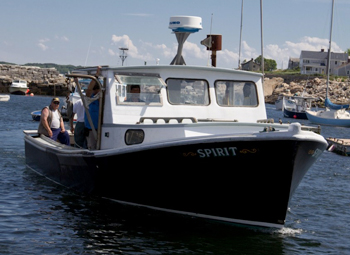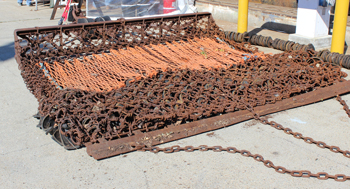Always Plan for the Unexpected
Fishermen’s accidents and how to avoid them
by Sandra Dinsmore

Bob Morris’ boat Spirit recently photographed in Cape Ann, MA. Morris was literally dragged into a near fatal accident aboard his boat in 2000. Safety drills saved his life. Bob Morris photo
“I had just finished replacing a hydraulic motor with my then 17-year-old son,” recalled Cape Ann lobster fisherman Bob Morris, 57, of a terrifying accident he had back in August of 2000. “We finished up the job, and I told him to wait in the skiff, which was tied alongside. We were on our mooring in the harbor. I told him I would go below and wipe down the tools and check for leaks in the lines before going ashore after a job well done. I did as I said and then noticed a few drops of hydraulic oil on the deck. That was the last thing I remember doing: bending down to wipe it up.”
Morris thinks his rolled-up right sleeve got caught in the unprotected U-joint of his running diesel.
“It reeled me in head-first to the deck, ripped off all my shirts, slammed my head against the bulkhead down there, and cleaned my right ear off. My right arm was pulled out of its socket and the shoulder dislocated. I had broken bone and ripped and torn muscles. In short, I was a mess. I was trapped on top of that shaft with the engine running. The bolts on the U-joint were grinding away at my left arm. I was helpless and hopeless.”
Two things saved Morris’s life: His teenage son’s quick action in shutting down the engine, but probably more important, that Morris had trained the boy—as he has trained everyone who ever stepped aboard his boats—how to shut down, where all the through-hull fittings are, how the pumps work, and anything that has to do with the captain not being able to do what must be done. And he readily admits the U-joint should have been covered.
Morris calls thinking safely being mentally tough and says it should be practiced on all boats. “I used to have my crews start up and shut down, identify the locations of pumps and through-hull fittings, basic navigation, and other areas of working on a boat, not because I was lazy,” he said, “but because I wanted them familiar with all processes of the boat. And the day did come when it saved my life. It could also one day save their own.”
To avoid another possible accident when having to climb forward in cresting seas or with an icy deck to attach a towline to the towing bitt, Morris has a towline already attached. It runs down the starboard rail and is tied to the base of the Davey where he hauls traps. “If I broke down,” he said, “all that would have to happen is for someone to throw me a line that I can attach in the safety of the cockpit.” He would cut or untie the twine that holds the towline from getting washed overboard and would be ready to be towed to safety without the risk of anyone being washed off the fore deck. The cost of having your own towline: about $20 at any marine supplies store.
Having a pre-attached towing line could help all kinds of fishermen, but as Port Clyde draggerman Gary Libby, 56, said, “The farther out a boat fishes the more dangerous it is, and the smaller the boat, the more dangerous it is. On draggers there is more danger because they’re out farther.”
Cutler lobsterman John Drouin, 50, who used to scallop and drag for quahogs, thinks draggers have the most issues with unexpected injuries and gave as an example handling the drag when it comes aboard. “With a scallop drag,” he said, “the drag is hanging there, and you are holding onto it to dump out the scallops. A wave comes along, and the boat rolls, the drag sways, and you are not expecting it. Yes,” he admitted, “we are always aware of the sea conditions, but when you are concentrating on doing one thing, and then something else happens, it can take you for a loop.”
Gloucester draggerman and dragger owner Russell Sherman, 69, factors in weather, heavy equipment, and stressors inherent in the dragging business. “It’s pulling nets across the sea floor, hanging them up on wrecks and other uncharted things, and trying to get them back,” he said. “There’s a lot of stress and strain involved in trying to retrieve your equipment. Each trawl door in a decent-size boat weighs a thousand pounds apiece. On larger boats, it’s even more. The cable between the trawl door and the net itself: You’ve probably got a couple of tons there; and a net weighs, I would guess, three or four thousand pounds.”

Big, heavy, hard and unforgiving. Scallop drags swinging around at the end of a cable on a rolling deck are one definition of hazardous duty. Fishermen’s Voice photo
To Sherman, though, the worst cause of accidents on draggers is fatigue. Nets are set out and towed along the bottom and then retrieved at a time set by the captain. “Typically, on an offshore vessel,” he said, “this goes on 24 hours a day, six or seven days at a time, so your fatigue factor is huge. Just huge.” He added that because pollock and cod have to be eviscerated, fishermen have to deal with a combination of very sharp knives and a pitching and rolling deck. Then, too, they also use fish forks and, to pick up flounders, a flounder pick, which Sherman calls basically an ice pick on a stick. He said, “I’ve been hit with those a couple of times by accident.
“There are all kinds of stresses and strains that can cause very serious accidents,” Sherman said. “This is big-time. Lobster gear, you know, some of those 20-pot trawls are pretty heavy, but you’re just dealing with rope. You’re not dealing with cables and thousands of pounds of weight. Winches for the trawl doors—mine holds 700 fathoms of quarter-inch wire, so you can see they’re heavy winches. You don’t get caught in them and then they stop. They only stop when somebody turns them off.” All this, Sherman said, while “grinding away for six or seven days, 24 hours a day.
“You get broken sleep,” he said. “You get three hours here and two hours here. You never get your four hours of good, solid REM. Very seldom do you. So you become used to sleeping for two hours.” He said sometimes sleeping for two hours is like sleeping for two days.
“And it’s hard to get good men,” the veteran dragger owner reported, unsurprisingly. “The danger factor for accidents goes up exponentially with the quality of the crew today.” He admitted, “I’ve had to take fellows that I wouldn’t walk across the street with.”
But draggerman Libby brought up required boat safety inspections and that draggermen have to pass a safety course themselves, so they know what to do in case of an emergency. “Actually,” Libby said, “there are a lot more things in place in a dragger to promote safety than there are on a lobsterboat. We have to check the bilge, make sure the pumps are running, have bilge alarms, make sure the machinery’s all running good, have guards over the belts, a guard around the exhaust, numerous things to stop small, foolish accidents. And then there’s always the catastrophic accident, like being knocked overboard by the net, or some big scallop drag falling on you, if you’re scalloping.’’ He said, “Things like that could be maintenance failures.”
But despite draggers being considered more dangerous than lobsterboats, Libby said, “As long as you’re doing your safety drill, you’re doing everything you can to keep yourself safe and using common sense.” Libby says he doesn’t have many accidents on his 50-foot dragger because he’s always paying attention to everything. “If everyone does that,” he said, “then the amount of accidents is going to be a lot less.” Libby takes one crewmember with him and said, “I check everything, so that brings into it more of a small-boat feel. You’re the owner-operator taking care of your business, being as careful as you can and realizing the danger. Those sorts of things go a long way to make people safe.”
Every fisherman interviewed suggested hiring other fishermen to help spread out the work. “Many hands make the workload lighter,” said Drouin. “To me, that is key. Doing this job with help will minimize work-related injuries.”
Morris and others suggest training crews in how to use bilge pumps and fire extinguishers; how to get home, and anything that pertains to staying alive. They insist that safety drills should be done on all boats. As Morris said, “For the few minutes it takes to teach someone, it makes no sense whatsoever not to.”
